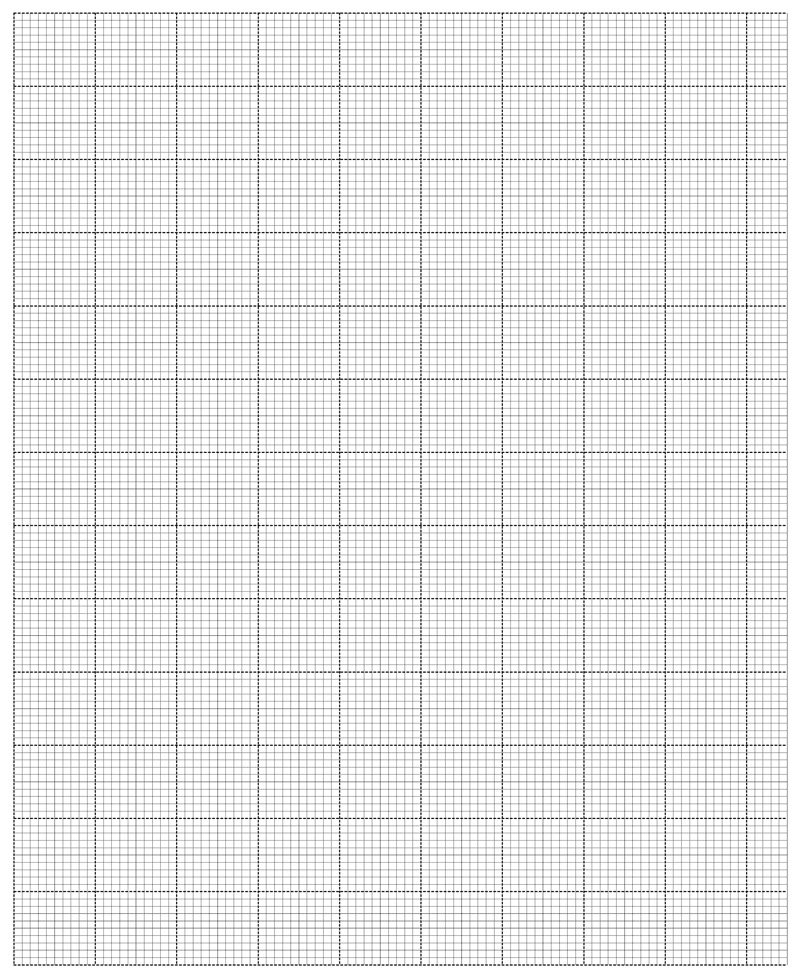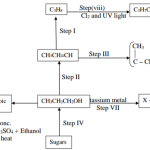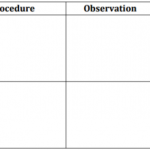KNEC KCSE Chemistry Paper 2 Question Paper / 2016 KASSU JET JOINT EXAMINATION
2016 KASSU JET JOINT EXAMINATION
Chemistry Paper 2
The grid below shows part of the periodic table. Use it to answer the questions that
follow. The letters do not represent actual symbols.
S U V
P R T X W
Q
(a)Which of the elements has the highest atomic radius? Explain. (2 marks)
………………………………………………………………………………………………
………………………………………………………………………………………………
………………………………………………………………………………………………
………………………………………………………………………………………………
……………………………………………………………………………………………….
(b)Identify the most reactive Oxidizing agent. Explain. (2 marks)
………………………………………………………………………………………………
………………………………………………………………………………………………
………………………………………………………………………………………………
………………………………………………………………………………………………
…………………………………………………………………………………………
(c) Compare the atomic radius of P and R. Explain (2 marks)
………………………………………………………………………………………………
………………………………………………………………………………………………
………………………………………………………………………………………………
………………………………………………………………………………………………
(d)Give the formula of one stable ion with an electron arrangement of 2.8 which is:
(i) A Negatively charged divalent ion. (2marks)
………………………………………………………………………………………
(ii) A Positively charged monovalent.
………………………………………………………………………………………
(e)Given that the mass number of W is 40. Write down the composition of its nucleus.
(2 marks)
………………………………………………………………………………………………
………………………………………………………………………………………………
………………………………………………………………………………………………
………………………………………………………………………………………………
………………………………………………………………………………………………
………………………………………
(f)Write the formula of the compounds formed between.
(i)Element R and X. (1 mark)
………………………………………………………………………………………………
(ii)Give one property of the structure formed when R and X bond. (1 mark)
………………………………………………………………………………………………
…………………………………………………………………………………………………………..
12 marks
An aqueous solution of zinc sulphate is electrolysed using platinum electrodes as shown in
the set up below.
(a) (i) Write a half equation for the reaction taking place at electrode A. (1mark)
………………………………………………………………………………………………………
………………………………………………………………………………………………………
(ii) Identify electrodes A and B (2 marks)
………………………………………………………………………………………………………
………………………………………………………………………………………………………
(iii) State and explain the observation at electrode B if copper plate was used instead of platinum
electrode. (2marks)
……………………………………………………………………………………………..……….
………………………………………………………………………………………………………
………………………………………………………………………………………………………
………………………………………………………………………………………………………
………………………………………………………………………………………………………
………………………………………………………………………………………………………
(b) 0.22g of metal Q is deposited by electrolysis when a current of 0.06A flows for 99 minutes.
(RAM of Q = 184, 1F = 9650oc)
(i) Find the number of moles of Q deposited. (1mark)
………………………………………………………………………………………………………
………………………………………………………………………………………………………
………………………………………………………………………………………………………
………………………………………………………………………………………………………
………………………………………………………………………………………………………
(ii) Determine the value of n in the metallic ion Qn+ (3marks)
………………………………………………………………………………………………………
………………………………………………………………………………………………………
………………………………………………………………………………………………………
………………………………………………………………………………………………………
………………………………………………………………………………………………………
………………………………………………………………………………………………………
(c) Determine oxidation number of chlorine in ClO3– (1mark)
………………………………………………………………………………………………………
………………………………………………………………………………………………………
………………………………………………………………………………………………………
………………………………………………………………………………………………………
………………………………………………………………………………………………………
………………………………………………………………………………………………………
(d) An iron spoon is to be electroplated with silver. Draw a labelled diagram to represent the set-
up that could be used to carryout this process. (2marks)
12 marks
(a)The scheme below was used to prepare a cleansing agent. Study it and answer the
questions that follow.
(i)What name is given to the type of cleansing agent prepared by the method above? (1mark)
………………………………………………………………………………………………………
(ii)Name one chemical substance added in step II (1mark)
………………………………………………………………………………………………………
(iii)What is the purpose of adding the chemical substance named in a (ii) above? (1mark)
………………………………………………………………………………………………………
………………………………………………………………………………………………………
(iv)Name any other suitable substance that can be used in step I (1mark)
………………………………………………………………………………………………………
(v)Explain how an aqueous solution of the cleansing agent removes oil during washing (2marks)
………………………………………………………………………………………………………
………………………………………………………………………………………………………
………………………………………………………………………………………………………
………………………………………………………………………………………………………
……………………………………………………………………………………….……………
(b).Study the scheme below and answer the questions that follow.
(i)Identify the catalyst used in step I (1mark)
………………………………………………………………………………………………………
(ii)Name the compounds A and B (2 marks)
A…………………………………………….B……………..……………………………………
(iii)Give one disadvantage of compound formed in step III (1mark)
………………………………………………………………………………………………………
………………………………………………………………………………………………………
(iv)Name the reactions taking place at steps: (1mark)
I………………………………………………….IV……………………………………………………………….
(v)Describe how substance K is converted to ethanol (2marks)
………………………………………………………………………………………………………
………………………………………………………………………………………………………
……………………………………………………………………………………………………..
………………………………………………………………………………………………………
13 marks
(a) State the Hess’ law. (1 mark)
………………………………………………………………………………………………………
………………………………………………………………………………………………………
………………………………………………………………………………………………………
……………………..………………………………………………………………………………..
(b) The enthalpies of combustion of calcium, carbon and decomposition of calcium carbonate are
indicated below;
C (s) + ½O2 (g) →CaO (s): ΔH=-635 kJmol-1
C (s) + O2 (g) →CO2 (g) ΔH=-394 kJmol-1
Enthalpy of decomposition of CaCO3 = +178 kJmol-1
(i)Draw an energy cycle diagram that links the enthalpy of formation of calcium carbonate to
enthalpies of combustion of calcium, carbon and decomposition of calcium carbonate.
……………………………………………………………………………………………(2 marks)
………………………………………………………………………………………………………
………………………………………………………………………………………………………
………………………………………………………………………………………………………
………………………………………………………………………………………………………
(ii)Determine the enthalpy of formation of calcium carbonate. (2 marks)
………………………………………………………………………………………………………
………………………………………………………………………………………………………
………………………………………………………………………………………………………
……………………………………………………………………………………………………
(c)Some average bond energies are given below.
| Bond C – C C – H Cl – Cl C – Cl H – Cl |
Energy in kJ mol-1 348 414 243 432 340 |
Calculate the energy change for the reaction below. (3 mks)
C2H6(g) + Cl2 (g) →CH3CH2Cl(g) + HCl(g)
………………………………………………………………………………………………………
………………………………………………………………………………………………………
………………………………………………………………………………………………………
………………………………………………………………………………………………………
………………………………………………………………………………………………………
………………………………………………………………………………………………………
………………………………………………………………………………………………………
………………………………………………………………………………………………..……..
8 marks
5.(a) Define the term solubility. (1 mark)
………………………………………………………………………………………………………
………………………………………………………………………………………………………
………………………………………………………………………………………………………
(b)In an experiment to determine the solubilities of two salts X and Y at different temperatures, a
candidate recorded her observations as shown below.
| Temperature (oC) | 0 | 10 | 20 | 30 | 40 | 50 | 60 | 70 | 80 | 90 |
| Solubility of X in g/100 g of H2O |
14.3 | 17.4 | 20.7 | 25.0 | 28.5 | 33.3 | 40.0 | 47.0 | 55.0 | 64.0 |
| Solubility of Y in g/100 g of H2O |
25.0 | 27.5 | 30.0 | 32.5 | 35.0 | 37.6 | 40.1 | 42.4 | 45.0 | 48.0 |
(a)On the same axes plot the solubility curves of X and Y. (4 marks)
(b)From your graph to determine;
(i)The solubility of X and Y at 47 oC
Solubility of X (1 mark)
……………………………………………………………………………………………………..
Solubility of Y (1 mark)
………………………………………………………………………………………………………
(ii)The temperature at which the two salts are soluble in water. (1 mark)
………………………………………………………………………………………………………
(c)If 60g of X is dissolved in 100 g of water and heated to 90oC, calculate the amount of salt that
crystallized out if cooled to 20 oC.(1 mark)
………………………………………………………………………………………………………
………………………………………………………………………………………………………
………………………………………………………………………………………………………
(d)State what would happen if a mixture salt X in 100 g of water and 30 g of Y in 100 g of water
were cooled from 90 oC to 70 oC. (3 marks)
(e)State one application of solubility.(1 mark)
………………………………………………………………………………………………………
8 marks
The flow chart below shows some processes in the extraction of zinc. Study it and answer the
questions that follow.
(a) Name the processes represented by A and E. (2 marks)
A…………………………………………………………………………………………………
E…………………………………………………………………………………………………….
(b) State the reagents required for processes B, C and D. (3marks)
B……………………………………………………………………………………………………
C……………………………………………………………………………………………………
D…………………………………………………………………………………………………….
(c) Write a chemical equation of the reaction that occurs in process B. (1mark)
………………………………………………………………………………………………………
………………………………………………………………………………………………………
(d) With an aid of a diagram, explain how you would obtain a pure sample of zinc by process E
(3 marks)
………………………………………………………………………………………………………
………………………………………………………………………………………………………
………………………………………………………………………………………………………
………………………………………………………………………………………………………
(e) State two commercial uses of zinc metal. (1 mark)
………………………………………………………………………………………………………
………………………………………………………………………………………………………
………………………………………………………………………………………………………
10 marks
The diagram below shows a set-up of apparatus that can be used to prepare nitrogen (IV)
oxide. Study it and use it to answer the questions that follow
(a) (i) Write the equation for the reaction that takes place in the boiling tube. (1 mark)
………………………………………………………………………………………………………
(ii) State the observations made in the boiling tube. (2 marks)
………………………………………………………………………………………………………
………………………………………………………………………………………………………
………………………………………………………………………………………………………
………………………………………………………………………………………………………
………………………………………………………………………………………………………
(iii) Explain why lead (II) nitrate is preferred over other metal nitrates in this experiment.
(1 mark)
………………………………………………………………………………………………………
………………………………………………………………………………………………………
(iv) Describe how gas A can be identified. (1 mark)
………………………………………………………………………………………………………
………………………………………………………………………………………………………
(b) (i)Name liquid B (1 mark)
………………………………………………………………………………………………………
(ii) Write a chemical equation to show how liquid B is formed in this experiment. (1mark)
(c ) (i) In another experiment, excess aqueous lead (II) nitrate solution was reacted with a
solution which contained 2.34g of sodium chloride. Calculate the mass of precipitate
formed in this reaction. (Pb = 207, Cl = 35.5, Na = 23) (3 marks)
………………………………………………………………………………………………
………………………………………………………………………………………………
………………………………………………………………………………………………
………………………………………………………………………………………………
………………………………………………………………………………………………
………………………………………………………………………………………………
(ii) Write an ionic equation for the reaction that takes place when nitrogen (IV) oxide
reacts with aqueous sodium hydroxide. (1 mark)
………………………………………………………………………………………………
………………………………………………………………………………………………
10 marks





